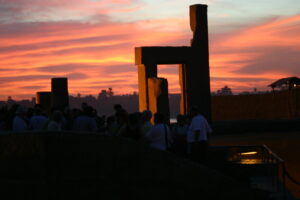
The Nile is Egypt, and Egypt is the Nile. Great kingdoms have flourished in Egypt for thousands of years. In fact, the glory period of the pharaohs reached its peak hundreds of years before the Vikings discovered North America, and still life goes on in a narrow belt of fertile land on both sides of the River Nile. Without the Nile’s water, Egypt cannot exist.
Egypt is located in the north end of Africa. Average annual rainfall is only 80 mm with as little as 1 cm falling on Cairo. Desert it is! At times a fierce wind crosses the land with winds to 140 kmph whipping sand and dirt into the air. It may last for days depressing the spirits of even the most determined residents. Running north from the mountains of Africa is the Nile River, second longest river in the world getting its water from three large rivers deep in the heart of Africa. Historically, peak flows caused floods that submerged the flood plain, covering it with much needed moisture, and a fresh layer of fertile silt, but at times it was excessive, destroying homes and crops, and at others it was insufficient, creating droughts.
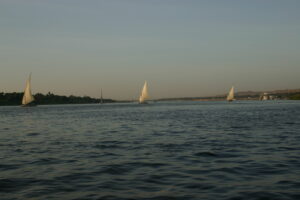
To control the flow the British built the Aswan Low Dam in 1902, and after increasing its height twice found it still inadequate. With Russian assistance, the Egyptians built the Aswan High Dam (1970) creating a huge reservoir that absorbed the excess water and created hydroelectric power for much of the country.
The heat of Cairo struck us as we stepped from the plane. Cairo’s airport does not use covered walkways so buses carry us to the terminal. This is the beginning of a period of chaos. There is only one luggage belt for the huge number of people that have just arrived, and already that belt is hidden behind a solid phalanx of jabbing, pushing, noisy people. Our built-in Canadian sense of fairness leaves us at a disadvantage. It’s not our nature to push in, and we make room for others. We’ll soon learn that is a huge mistake… one tiny opening allows for entire groups to slip in ahead of us from both sides. It’ll take time, but we’ll soon learn how to use the elbows, feet, and other blocking methods to secure our own pathway. One person at the belt reaches for his luggage over the top of someone else who won’t giveway. He hasn’t got a good grip and the luggage and his arm proceed to mow down several waiting people. Oh well! Some time later we reach the bus. Welcome to Egypt.
Once you’ve been there, the memory of Cairo’s traffic will remain with you forever. Each driver pushes ahead as if there were no one else on the road. This includes the bus driver. All progress must be accompanied by repeated horn blowing. On the main drive there are four marked lanes each way. Sometimes there were 5 lanes of traffic. It seems, too, that if you drive with your wheels in two lanes it doubles your options on which way you can dart. Just like at the luggage belt at the airport, no one allows an opening to appear without using it.
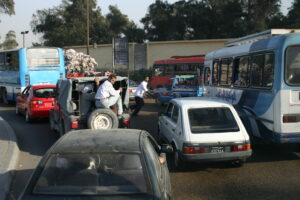
Push your vehicle in and others will yield… and they do. We saw no accidents even though fast vehicles would catch up to donkey carts, or pedestrians, or cars stopped in the lane, and veer around them. It’s an incredible scene that resembles a huge video car race.
Years of reading about the great pyramids had created a yearning to see them in person and at last I’m in the city of Giza, on the west bank of the Nile River just across the river from Cairo. The drive to the pyramids is along a quieter street and is our first chance to see the older Egypt. Here and there we meet or pass donkeys and carts loaded with market vegetables, and flowers. Often there are pedestrians walking with the carts. The wheels of the carts wobble and shake as if ready to quit any moment. Bicycles are used as mini-trucks carrying stacks of crates, or anything that they can tie onto them. Motorcycles have a seat over the rear wheel for passengers who ride sidesaddle. And all of these mix with the faster car and truck traffic. We drive along a canal that is crossed by riding in small boats fastened to a rope across the canal. There are several of these private passenger ferries spaced along the canal.
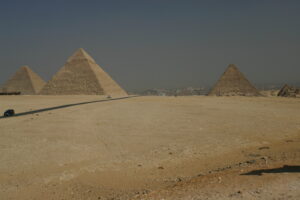
We rise onto a rocky plateau and come upon the pyramids quickly. They were built up on the plateau to avoid the softer sinking soils of the river plain. The great pyramid, built almost 5000 years ago, is impressive. The blocks of solid rock, some nearly as tall as a human, are fitted together so tightly it would be difficult to slip a business card into the crack. What fantastic skills and patience the craftsmen had to cut and shape these blocks so perfectly.
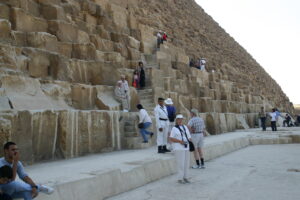
The huge rocks climb stepwise to the top. At one time there was a smoother veneer of rocks over them but most were taken for construction in other places. You have to wonder that people, including some pharaohs, would damage these places of burial that meant so much to earlier generations, to make use of the material for their own needs.
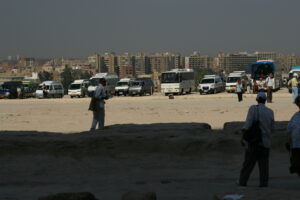
Perhaps it’s the huge lines of tourist buses, and the masses of people walking and taking pictures, but there is very little feeling in the air that these were the burial places of other humans. They are just impressive piles of rocks. The great pyramid is 146 metres high and 229 metres on each side. The sides are almost exactly the same length on each side and at a true ninety-degree angle… who of us does not remember the Pythagorean Theorem? And this was done without a transit and modern level.
We drive up the road to a viewpoint higher on the hill. The scene from here is the traditional view seen in pictures of the three pyramids surrounded by the dry desert. The view is marred by a huge set of bleacher seats that has been erected near the pyramids. The buildings of Giza are visible in the valley beyond. It’s hot here, but the breeze along the top of the hill helps keep us comfortable, but this is the cool season.
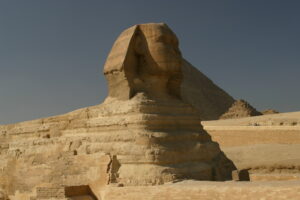
A view of the sphinx completes the picture. Mysterious, and impressive, this animal with the head of a man sits above the valley looking across the fertile land of the Nile as if on guard. Who built it, is in question. To me, the sphinx, along with the pyramids, represents Egypt. I wonder if there are tombs below the sphinx, but digging has not been done to find out. It is possible to enter the pyramids but the corridor is very low, narrow, dark, and long. We didn’t go!
Later, in the Valley of Kings we did get the opportunity to enter the tombs of Rameses III, Rameses VI and Rameses IX. These tombs are located in a dry mountain alongside a dry river. The burial chambers are found at the ends of long corridors dug into the rock of the mountain. The corridors were not claustrophobic, in fact were huge, perhaps twelve feet high and quite wide. The wall, and ceilings were completely engraved with hieroglyphics and pictures, some of them coloured. All along the sides of the corridor were smaller alcoves. Again, there is the mystery of how this stonework was done so meticulously without the aid of modern tools.
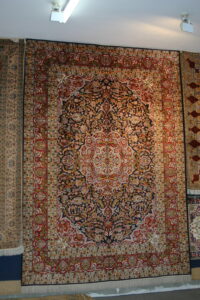
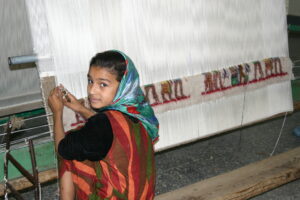
Egypt has few industries. Carpet making is a proud tradition and the resulting carpets are magnificent. We visited a carpet school that seemed to be a combination school and factory. Young children sat in front of unfinished carpets with a row of threads above their heads. Reaching quickly for a required colour their fingers would fairly fly as they wove it into place while an older youth called out the pattern. When another person came by and shaved the work it looked beautiful. While it may look to some as child labour, these young people looked happy, and were certainly learning a useful skill.
Alabaster was a prized material for making special objects. It is a softer material than marble and if the handler of the object is not careful it can be discoloured because it absorbs oils, and dirt and grime can be very easily rubbed into it. We observed a small group working with the raw material ending up with a beautiful vase.
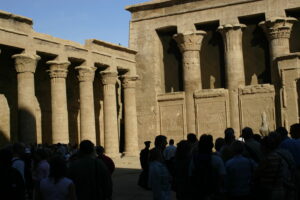
Many visitors to Egypt opt for a cruise of the Nile expecting to put in some leisurely hours watching the shore pass by in between trips on shore to visit some of the temples. Along the upper reaches of the Nile within Egypt there are many temples. Many feature massive columns and lying upon them huge blocks of stone that act as roofing material. The ancient Egyptian’s skill in hewing and shaping large stones remains among the most impressive of the wonders of ancient Egypt.
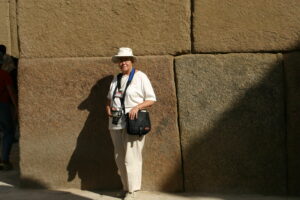
The fertile moist land along the Nile creates a verdant oasis that stretches for hundreds of miles. Thick stands of palms alternate with open fields. Cattle and goats graze the wetter fields near the water. The occasional cow will be observed soaking in the river, sometimes right up to its neck. Fortunately crocodiles do not make their way north of the Aswan Dam.
Most people visiting Cairo are not going to see much of the city’s nightlife. They will likely be taken to one of the better hotels and travel from there to see the historical buildings by bus, and return. Rooms are likely going to be nice. There will often be an enclosed courtyard with decoration, and a restaurant will be present. Going out to see the night sights was not an option. The few times that we were out in the bus heading for the airport we saw that for the locals, life continues all night. People walked and shopped constantly at small shops and tiny grocery stores whose fruits and vegetable filled all available space outside the building’s entrance.
North Americans take a while to adjust to the level of security present everywhere in Egypt. There are the Antiquity police, the Tourist police, the regular police, the army, and those in disguise. The disguised ones are all cut from the same cloth. They will be young men, cleanly shaven, short hair, brown pants, brown jacket, shirt and no tie, and the jacket is always open so they can easily reach their massive multishot 9mm pistol that is slung at their side just under the jacket. They are everywhere, sometimes in front, or beside, or behind. Their attempts to blend in makes them so obvious that it’s humorous. Most of the security folk carry large rifles openly. The way they handle their guns often tends to be next to foolish. Some pick up the rifle by the muzzle, others dangle it so the muzzle is in the dirt, or they point it at their legs and feet. In a couple of places the armed men stood behind steel shields on wheels. This is life in Egypt.
We enjoyed our visit to Egypt and never expected it to be like home. If it had been we would have been disappointed. It’s a rewarding experience to visit a civilization that’s been developing for several thousand years. The many temples and statues give rise to questions as to how they came about, and why. If we were to go again, we would be able to make definite suggestions to the tour company as to what we would be expecting them to provide us with.
-30-
Sidebar 1
Be very careful when choosing a Nile cruise. What we thought would be a five day Nile cruise turned out to be mostly four days of floating hotel and one day of pleasant cruising. Other sailings were either done when we were on the bus, or at night when it was impossible to observe the scenery. This part of our trip was very disappointing to us. These cruise boats also will tie up to each other perhaps three deep. The great river view you had from your cabin window can suddenly turn into the view of a ship’s side only an arm’s length away. Also, the constantly running diesels generate a lot of diesel smoke that makes its way into your cabin or onto the recreation deck.
This situation generated an amusing few moments when guests of our boat were enjoying a few drinks around the deck tables. Another ship pulled up beside and tied up. Facing everyone was an open bedroom with two people sleeping unaware that their bedroom was now on display. Suddenly the lady woke and sat up to see a deck full of people laughing at them. Life on the river can be full of surprises.
Sidebar 2
It is necessary to be vigilant where your health is concerned. Before going, ask your health unit and your doctor what shots and medicines you should be taking.
The water is to be considered unsafe. Avoid the salads and any fruits that might have been washed in local water. Don’t assume that since you are in a good hotel you don’t have to take precautions. Check to see if the tea and coffee have been made from boiled water, not just hot water. Are the ice cubes in your drinks safe?
Many of your meals will be buffet. Are the meats cooked well? I found beef meatballs that were raw in the centre, and stir-fried chicken that was not cooked inside. In one hotel the heated chaffing dishes were cool enough to place your hand on the top. Inside the beef dish, the gravy was solidified over as if the food had sat from an earlier meal.
Buy sealed bottled water and even use it to brush your teeth. Don’t rinse the toothbrush under the tap.
Sidebar 3
There were very few beggars. But, street sellers were everywhere. They are aggressive in their pitches. Don’t speak to them or you’ve lost half the battle. If you want something, offer less than two thirds what they asked, and that may be too much. Outside the temples and pyramids, be prepared to push through hordes of them with their outstretched arms holding their treasures.

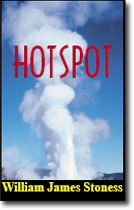
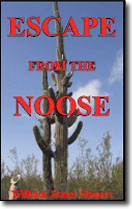
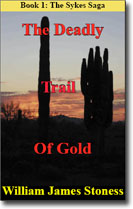

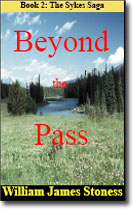
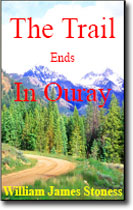
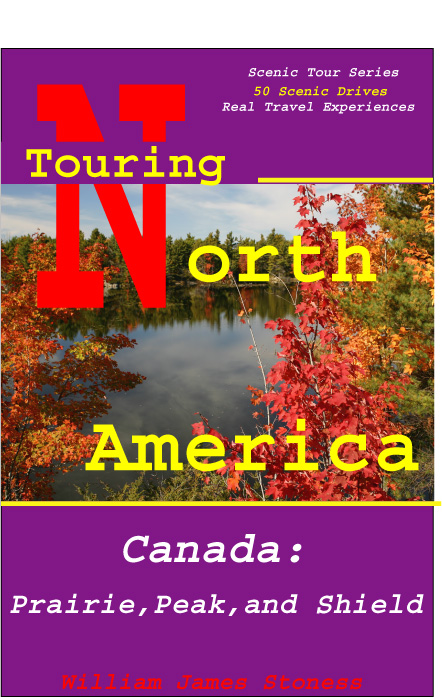

Recent Comments